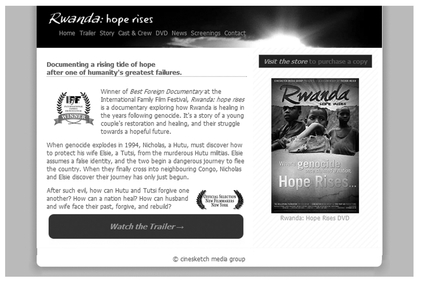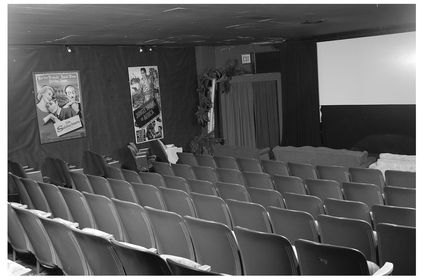68
How to Make a Documentary: Distribution
Morgan Paar

Figure 68-1
You found a compelling story that the world needs to know about; you gathered up enough money to get the documentary through preproduction, shooting and post-production and your family and friends loved it. Now put your finished doc in your closet and go watch TV. NO! You’re not done yet.
Distribution is something that you should have been thinking about since pre-production; not only thinking about but also including in your planning and budgeting. Every filmmaker should know from the beginning what is most important to them in regards to their product. Are you hoping to be the next Francois Truffaut who is mobbed at Sundance and Cannes by reporters and fans or are you more interested in selling your film? Both are admirable goals but their paths may vary.
Film Festivals
For many, the festival circuit is the first and maybe only step they will take.

Figure 68-2 Withoutabox.com is a platform that allows the user to search more than 3,000 film festivals. A great resource for independent video producers who want to distribute their documentary.
Research five to 20 festivals that your documentary will have a good chance to compete or screen in. Find some safe ones and some ambitious ones. Does your hometown sponsor a local festival where your doc will have local relevance? Be sure to send your work to one or more of the majors: Cannes, Sundance, The Academy Awards, etc. Why not? Aim high. During pre-production you took note of the festival’s requirements, so you have everything you need: release forms, production stills, multiple DVDs of your video, subtitles if necessary, entry fee, etc. Mail them in before the deadline and prepare your acceptance speech for the big win.
The website Withoutabox seems to be the most comprehensive hub for festivals these days ( withoutabox.com). In fact, many festivals insist you use this service. Set-up a profile and let it work for you. You can also search the Web for festivals that are appropriate for your documentary. Most have a $30–$50 entrance fee. With all the other supporting material (e.g. production stills, multiple DVD copies, shipping costs, etc.), a single entry could cost close to $100 so pick your festivals carefully. And you may want to budget airfare and accommodation to a festival or two in order to accept the statuette in person.
Film Markets
Film markets are the place to sell your documentary. Generally speaking, this is the route towards fortune as opposed to the dream of fame at a festival. Film markets are usually large, chaotic “swap meets” where distribution companies or sales agents meet face to face with filmmakers to make deals for television, theatrical or DVD sales. To add a layer of complication, many agents will represent specific foreign markets so you might be negotiating with one agent to have your documentary play in theatres in India and another company to air on Argentine TV.
Many markets are associated with big film festivals such as the European Film Market at the Berlin Film Festival (EFM), TIFFCOM at the Tokyo International Film Festival and Cannes Film Market at the Cannes Festival. Others are not attached to festivals such as the American Film Market in Santa Monica, California. Find out as much as you can about a distributor’s desires and needs so that you are prepared to successfully sell your documentary.
Distributors
Finally, if schmoozing and negotiating at film markets is not for you, you can approach distributors directly. The internet is your friend here as there are all sorts of niche companies offering just about any kind of distribution deal you can think of. For example, if your documentary has educational relevance, there are a number of organizations that specialize in distributing to schools. Some of these distribution companies are very niche, so do your research and don’t hesitate to contact them with questions (preferably in pre-production). Remember, they are making money from your hard work so they should be happy to answer your questions. Wikipedia.com and Filmforum.org are two websites that list film distributors around the world.
There are new websites popping up (and disappearing) every day that “distribute” documentaries. Some will pay you and some won’t. Some will attach an advertisement to your work and share the ad revenue with you. Even if you don’t get paid, it might pay off in the end if someone from a production company sees your documentary, contacts you and wants you to shoot their next documentary.
Website
Whichever path you take, it’s a wise idea to have a website solely for your documentary. It doesn’t have to be fancy, in fact, many times simple is better. A relevant URL name helps. If my documentary is called The Cute Kittens of Kansas City, www.CuteKittens.com would be great. It’s probably taken, so www.CuteKittensTheDoc.com could work. Have a trailer and contact information at a minimum. Production stills, crew bios, subject bios, names of festivals where the documentary played or won awards, etc., are all relevant.

Figure 68-3 A simple website with a trailer and contact information as well as production stills, crew bios, and awards is a great idea for showcasing your documentary. Be sure to use a URL that is relevant to the documentary and is SEO (Search Engine Optimizing) friendly.
Television
Public Television, cable television and syndication are all avenues worth looking into. This route has become a less traveled road with the rise in popularity of the internet but if you had aired your documentary on the Discovery Channel or the National Geographic Channel, you’d have bragging rights for sure. Make some official looking letterhead, find out who makes the programming decisions and snail-mail them a skillfully written one page letter describing why their station needs to air your documentary Chances are they will not call you back. After about two weeks, contact them again. Persistence is the name of this game.
You will need to know exactly what the station wants and needs before you roll tape. PBS has their Proposal Guidelines and Red Book (technical and legal guidelines) online as a downloadable PDF file. If you can’t find a station’s guidelines online, call the station directly and ask to speak with the program or editorial management.
Public-access television used to be the way us “little folk” got our videos seen. These stations, and sometimes full production and post-production studios still exist, but have taken a back seat to cable television and the internet. Wikipedia has a list of public access TV stations in the United States.
RSS and Web Syndication
We’ve heard some success stories of ambitious filmmakers getting their docs out via RSS feeds (Really Simple Syndication). You’ll need to create some buzz (see below) in order to get the word out that

Figure 68-4 Romeo-Theater.com is a place for independent video producers to submit their work and be featured on the site.
your documentary is available for download via an aggregator site. John Romeo, a Richmond, Virginia filmmaker, started a sight that shares short videos through the Web or by RSS from iTunes. You can submit your doc to his site: Romeo-Theater. com. He also has some interviews with the directors of some of the movies you’ll find there—good insight.
Do-It-Yourself
“Four-Walling” is a technique that has been used by indie filmmakers over the years. Typically, one rents a movie theatre and its staff for a flat fee. The filmmaker is responsible for filling the seats (read: advertising) and decides if admission will be charged. Four-Walling is a bit more challenging with the near disappearance of small, “mom and pop” type, art theatres.
The worker-owned and operated Red Vic in San Francisco is a good example of a theatre that rents its 145-seat theatre to independent filmmakers. They even have a marquee! Colleges or even high school theatres are a viable though less glitzy option to project your doc in a typical theatre atmosphere.
Create that Buzz
And finally, no matter which of these directions you take to get your documentary out to the masses, you’ll want to think about creating a bit of “buzz” for your project. Put together a press kit (synopsis, cast and crew bios, technical information, director’s statement, production stills, reviews and contact information), your website, as mentioned above and possibly postcards if you are headed to festivals (these are cheap to print these days, have an experienced designer lay the design out digitally for printing). If you fancy yourself to be a creative entrepreneur, you may be able to figure out a way to make your doc, trailer or project concept “go viral” before you even approach a festival or market, similar to the way The Blair Witch Project was being talked about before it reached theatre. Create that buzz.
You are Now a Documentary Filmmaker
Almost every one of these paragraphs, sentences even, can be an article in itself.

Figure 68-5 Four Walling is used by many independent video producers to showcase their film to audiences. Many locales have independent theatres they can rent for the occasion.
This was a sprint through the entire process, from initial idea to final distribution. There are many excellent books that further detail each of these steps in producing and distributing a documentary. I hope this article inspires you to research each of these steps further and, ultimately, I hope it inspires you to take the first step in producing your story.
See you at the awards ceremony.
